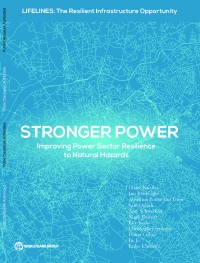World Bank: Stronger Power: Improving Power Sector Resilience to Natural Hazards - June 2019 - eng (pdf)
The power sector is both highly vulnerable to natural hazards and a priority for any country'srecovery and reconstruction. After Hurricane Maria in Puerto Rico in 2017, most of the power gridwas down. One year and tens of billions of dollars later some customers were yet to be reconnected to the main grid. This type of long and widespread power outage has major consequences on people's health and well-being, for instance through lacking access to refrigeration for food and medicine, and on the ability of firms to produce and provide people with goods, services, jobs, and income. In most countries, the power system is designed to cope with high-frequency but relatively low impact events. Low-frequency, high-impact events – such as many natural disasters – are rarely considered fully, and the implementation of planned management measures is often patchy. Furthermore, the power system is a special kind of infrastructure due to the heterogeneity of the generation assets and its wide spatial distribution. The latter means that power systems are often exposed to natural hazards and sometimes to more than one hazard, leading to high repair costs when disasters strike. This paper, prepared as a sectoral note for the Lifelines report on infrastructure resilience, investigates the vulnerability of the power system to natural hazards and climate change, and provides recommendations to increase its resilience. It first describes how power outages are often the consequence of natural disasters and outlines the main vulnerabilities of the power sector. It then proposes a range of approaches and solutions for building a more resilient power sector – from increased robustness to greater flexibility – showing that the additional cost of resilience is not high if resources are well spent. Finally, it describes how emergency preparedness and disaster recovery encompass not only technical aspects, like asset strengthening or criticality analysis, but also "softer" skills, like governance, regulatory or capacity building, and education.
Дополнительная информация
- Серия: Международные организации / World Bank / Economic and Sector Work (ESW) Studies
- Год: 2019
- Месяц: 6 (полугодие)
- Источник: World Bank


































